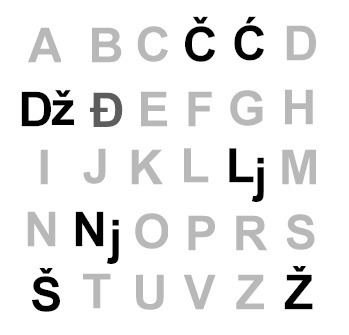 | ||
Gaj's Latin alphabet (Serbo-Croatian: abeceda, latinica, or gajica) is the form of the Latin script used for Serbo-Croatian (Bosnian, Croatian, Serbian, and Montenegrin). It was devised by Croatian linguist Ljudevit Gaj in 1835, based on Jan Hus's Czech alphabet. A slightly reduced version is used as the script of the Slovene language, and a modified version is used for romanization of the Macedonian language. Pavao Ritter Vitezović had proposed an idea for the orthography of the Croatian language, stating that every sound should have only one letter.
Contents
Today Gaj's alphabet is used in Bosnia and Herzegovina, Croatia, Montenegro and Serbia.
Letters
The alphabet consists of thirty upper and lower case letters:
Gaj's original alphabet contained the digraph ⟨dj⟩, which Serbian linguist Đuro Daničić later replaced by the letter ⟨đ⟩.
The letters do not have names, and consonants are normally pronounced as such when spelling is necessary (or followed by a short schwa, e.g. /fə/). When clarity is needed, they are pronounced similar to the German alphabet: a, be, ce, če, će, de, dže, đe, e, ef, ge, ha, i, je, ka, el, elj, em, en, enj, o, pe, er, es, eš, te, u, ve, ze, že. These rules for pronunciation of individual letters are common as far as the 22 letters that match the ISO basic Latin alphabet are concerned. The use of others is mostly limited to the context of linguistics, while in mathematics, ⟨j⟩ is commonly pronounced jot, as in German. The missing four letters are pronounced as follows: ⟨q⟩ as ku or kju, ⟨w⟩ as dublve or duplo ve, ⟨x⟩ as iks, ⟨y⟩ as ipsilon.
Digraphs
Note that the digraphs ⟨dž⟩, ⟨lj⟩, and ⟨nj⟩ are considered to be single letters:
Origins
The Croatian Latin was mostly designed by Ljudevit Gaj, who modelled it after Czech and Polish, and invented ⟨lj⟩, ⟨nj⟩ and ⟨dž⟩. In 1830, he published in Buda the book Kratka osnova horvatsko-slavenskog pravopisanja ("Brief basics of the Croatian-Slavonic orthography"), which was the first common Croatian orthography book. It was not the first ever Croatian orthography work, as it was preceded by works of Rajmund Đamanjić (1639), Ignjat Đurđević and Pavao Ritter Vitezović. Croats had previously used the Latin script, but some of the specific sounds were not uniformly represented. Versions of the Hungarian alphabet were most commonly used, but others were too, in an often confused, inconsistent fashion.
Gaj followed the example of Pavao Ritter Vitezović and the Czech orthography, making one letter of the Latin script for each sound in the language. His alphabet mapped completely on Serbian Cyrillic which had been standardized by Vuk Karadžić a few years before.
Đuro Daničić suggested in his Rječnik hrvatskoga ili srpskoga jezika ("Dictionary of Croatian or Serbian language") published in 1880 that Gaj's digraphs ⟨dž⟩, ⟨dj⟩, ⟨lj⟩ and ⟨nj⟩ should be replaced by single letters : ⟨ģ⟩, ⟨đ⟩, ⟨ļ⟩ and ⟨ń⟩ respectively. The original Gaj alphabet was eventually revised, but only the digraph ⟨dj⟩ has been replaced with Daničić's ⟨đ⟩, while ⟨dž⟩, ⟨lj⟩ and ⟨nj⟩ have been kept.
Computing
In the 1990s, there was a general confusion about the proper character encoding to use to write text in Latin Croatian on computers.
The preferred character encoding for Croatian today is either the ISO 8859-2, or the Unicode encoding UTF-8 (with two bytes or 16 bits necessary to use the letters with diacritics). However, as of 2010, one can still find programs as well as databases that use CP1250, CP852 or even CROSCII.
Usage for Slovene
Since the early 1840s, Gaj's alphabet was increasingly used for the Slovene language. In the beginning, it was Slovene authors who treated Slovene as a variant of Croatian (such as Stanko Vraz) who most commonly used it, but it was later accepted by a large spectrum of Slovene-writing authors. The breakthrough came when the Slovene conservative leader Janez Bleiweis started using Gaj's script in his journal Kmetijske in rokodelske novice ("Agricultural and Artisan News"), which was read by a wide public in the countryside. By 1850, Gaj's alphabet (known as gajica in Slovene) became the only official Slovene alphabet, replacing three other writing systems which circulated in the Slovene Lands since the 1830s: the traditional bohoričica (after Adam Bohorič who codified it) and the two innovative proposals by the Peter Dajnko (the dajnčica) and Franc Serafin Metelko (the metelčica).
The Slovene version of Gaj's alphabet differs from the Croatian one in the following traits:
Slovene orthography is comparatively less phonetic than Serbo-Croatian. For instance, letter ⟨e⟩ can be pronounced in three ways (/e/, /ɛ/ and /ə/), and letter ⟨v⟩ in two (/ʋ/ and /w/). Also, it does not record consonant voicing assimilation: compare e.g. Slovene ⟨odpad⟩ and Serbo-Croatian ⟨otpad⟩ ('junkyard', 'waste').
Usage in Macedonian
Romanization of Macedonian is done according to Gaj's Latin alphabet but is slightly modified. Gaj's ć and đ are not used at all, with ḱ and ǵ introduced instead. The rest of the letters of the alphabet are used to represent the equivalent Cyrillic letters. Also, Macedonian uses the letter dz, which is not part of the Serbo-Croatian phonetic inventory. However, the backs of record sleeves published in the former Yugoslavia (such as Mizar's debut album) used ć and đ, like other places.
